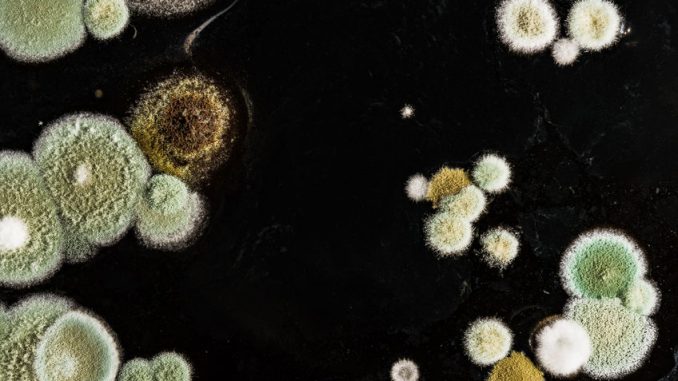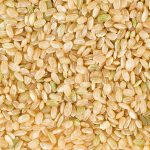
Mycotoxins are ubiquitous toxic metabolites produced by fungi via secondary metabolism. Many of them are contaminants, often finding their way into food, beverages and water. They pose a significant food safety risk as cancer causing agents and are poisonous to cause death (Pitt and Miller, 2016). The general term used for causing disease and death is mycotoxicosis.
Despite efforts to control fungal contamination, toxigenic fungi are found widely in nature. They occur worldwide in food supplies as a result of poor control over the supply chain. In many instances where mismanagement of food processing and storage has occurred we find mould infestation of susceptible agricultural products, such as cereal grains, nuts and fruits.
The natural fungal flora associated with foods is dominated by the filamentous types, Aspergillus, Fusarium, and Penicillium species (Murphy et al., 2006). All these produce mycotoxins of considerable concern to human and animal health (Cramer et al., 2007). At least 400 different mycotoxins have been isolated and there are still more being discovered (Campone et al., 2018; Gayathri et al., 2018).
Most of the mycotoxins isolated are contaminants of grain which are key ingredients in the human diet (Hassan et al., 2018). It is thought by the Food and Agricultural Organization (FAO) that about a quarter of the world’s supply of grain is contaminated by mycotoxin producing moulds, so clearly they still represent a major health hazard. Indeed, many of them carcinogens (Lim et al., 2015).
There are a number of types of mycotoxin which have been discussed separately elsewhere on this web-site. The reader is directed to those specific articles for interest. We have covered aflatoxins, deoxynivalenol, ochratoxins, patulin, zearalenone to name a few.
History
As soon as mankind began cultivating crops of all sorts and stored them from one season to the next, then moulds began to probably impact on human health. The move to an agrarian lifestyle started around 10,000 years ago so this particular food safety issue has been present for a very long time.
Storage of grains implies a new ecological niche was created for all fungi including those pathogenic to humans. A number of others would not only be major spoilers of crop but were saprophytes too of the stored grains. The large availability of such stores over extended periods of time has meant considerable opportunities for moulds of all sorts to adapt to storage conditions.
The first hints of major mycotoxin poisoning comes from writings about 2000 years ago. Ergotism is a condition caused by mycotoxins produced by Claviceps purpurea. These mycotoxins caused the probable deaths of many people throughout Europe. The severe illness caused by consuming mouldy rice has been known about in Japan and China since the 1600s. The condition known as acute cardiac beriberi was due to the presence of citreoviridin, produced by Penicillium citreonigrum. Although it sporadically emerges throughout history, major outbreaks occur in drinking water and recently emerged in Brazil. Ochratoxin A is one of many Penicillium toxins for example. It is thought to have caused Balkan endemic nephropathy which is a severe, often fatal condition afflicting the kidneys. Russia has also experienced particular food poisoning due to to mycotoxins. The Fusarium moulds produce T-2 toxins which caused alimentary toxic aleukia in the 1940s during and after World War II. Another groups of Fusarium toxins, the fumonisins produced equine leucoencephalomalasia. Lately, there has been considerable research expended on the production of aflatoxins in grains and nuts by Aspergillus flavus. The aflatoxins act in synergy with hepatitis B virus to induce liver cancer.
A significant review of research into mycotoxins is worth reading by Pitt and Miller (2016).
Impact In The Gut
Mycotoxins generally affect the gut especially the intestinal epithelial cells lining the digestive tract. There appears to be significant evidence that gut microbiota are capable of eliminating the threat posed by mycotoxins provided the host is healthy enough and has a balanced gut flora and fauna. Unfortunately, many of the mycotoxins in sufficients quantities disrupt the microbiota which in turn has a knock-on effect.
Analysis Of Mycotoxins
Currently, the major methods to analyse mycotoxins include high‐performance liquid chromatography (HPLC), thin‐layer chromatography (TLC), enzyme‐linked immunosorbent assays (ELISA) and gas chromatography–mass spectrometry (GC‐MS). The most common approach for analysis is to conduct an immunoaffinity column clean up of an extracted sample followed by HPLC.
All these technologies require not only considerable expertise to operate and analyse the data, they also demand costly equipment and reagents. In some cases the availability of reagents, especially antibodies for analysis are considerably limiting because of their high production costs, instability and scarcity. Their operation is also time consuming and in many cases the toxins do not have toxicological assessments associated with them (Gong et al., 2015; Yin et al., 2018).
Many countries in the developing world lack the resources to prevent and control accumulation of mycotoxins in their supply chain. The most vulnerable parts of the supply chain are the agricultural commodities especially grains and cereals, whilst fruit and drinking water are not far behind.
Clearly, as we experience considerable increases in human populations, the need to monitor our food and manage our supplies is ever increasing. The risk of mycotoxin contamination is ever present and there is increasing concern that food poisoning outbreaks as a result is rising.
References
, , et al. (2018). Rapid and automated on‐line solid phase extraction HPLC‐MS/MS with peak focusing for the determination of ochratoxin A in wine samples. Food Chemistry, 244, pp. 128–135. https://doi.org/10.1016/j.foodchem.2017.10.023
, & (2007). Stable isotope dilution analysis of the Fusarium mycotoxin zearalenone. Journal of Agricultural and Food Chemistry, 55, pp. 8353–8358. https://www.ncbi.nlm.nih.gov/pubmed/17880160?dopt=Abstract
, , et al. (2018). Metabolism‐dependent cytotoxicity of citrinin and ochratoxin A alone and in combination as assessed adopting integrated discrete multiple organ co‐culture (IdMOC). Toxicology in Vitro, 46, pp. 166–177. https://doi.org/10.1016/j.tiv.2017.09.022
, & (2015). Molecular strategies for detection and quantification of mycotoxin‐producing Fusarium species: a review. Journal of the Science of Food and Agriculture, 95, pp. 1767–1776 https://doi.org/10.1002/jsfa.6935
, , et al. (2018). Detection of toxigenic mycobiota and mycotoxins in cereal feed market. Food Control, 84, pp. 389–394. https://doi.org/10.1016/j.foodcont.2017.08.032
, , et al. (2015). Multi‐mycotoxin screening reveals separate occurrence of aflatoxins and ochratoxin a in Asian rice. Journal of Agricultural and Food Chemistry, 63, pp. 3104–3113
Murphy, P. A., Hendrich, S., Landgren, C., & Bryant, C. M. (2006). Food mycotoxins: An update. Journal of Food Science, 71, R51–R65.
& (2016). A concise history of mycotoxin research. Journal of Agricultural and Food Chemistry, 65, pp. 7021–7033. https://www.ncbi.nlm.nih.gov/pubmed/27960261?dopt=Abstract
, , et al. (2012). Quantitation of mycotoxins in food and feed from Burkina Faso and Mozambique using a modern LC‐MS/MS multitoxin method. Journal of Agricultural and Food Chemistry, 60, pp. 9352–9363 https://pubs.acs.org/doi/10.1021/jf302003n
, , et al. (2018). Engineering a universal and label‐free evaluation method for mycotoxins detection based on strand displacement amplification and G‐quadruplex signal amplification. Sensors and Actuators B: Chemical, 256, pp. 573–579. https://doi.org/10.1016/j.snb.2017.10.083
<
p align=”LEFT”>

Leave a Reply